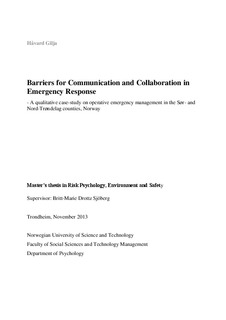Barriers for Communication and Collaboration in Emergency Response: A qualitative case-study on operative emergency management in the Sør- and Nord-Trøndelag counties, Norway
Master thesis
Permanent lenke
http://hdl.handle.net/11250/271190Utgivelsesdato
2013Metadata
Vis full innførselSamlinger
- Institutt for psykologi [3086]
Sammendrag
The present thesis is a qualitative empirical case-study on operative emergency management in the Sør- and Nord-Trøndelag counties, in Norway. The organized response to emergencies often demands the instigation of a variety coordinated actions by multiple organizations and organization levels in order to minimize harm and loss. This work organization often characterizes emergency management. Major events and some types of events demand a scaling up of resources (e.g., materials, personnel, expertise) in both horizontal (more organizations or organizational units) and vertical (crisis management levels) manner. These organizational extensions add new layers of complexity and may introduce or increase problems linked to matters such as decision making, information sharing, procedures, routines, information and communication technology, resource allocation, collaboration, leadership, teamwork, knowledge, trust, etc. Two crucial features for an emergency response system to be well-functioning are communication and collaboration, both intra- and inter-organizationally. The present thesis aims to identify and describe barriers that may limit or hinder effective communication and collaboration within and between emergency response organizations and explores how these two phenomena are affected by horizontal and vertical organizational extensions. Several empirical studies have investigated communication and collaboration within and between the professional emergency agencies (i.e., the police, the fire- and rescue service, and the health service). However, few have explicitly sought to uncover the possible problematic aspects linked to the presence of support- and reinforcement organizations. Therefore, these aspects are given special attention here. Twelve mid-level leaders from six different emergency response organizations have been interviewed. The organizations include three professional emergency agencies (the Police, the Fire- and Rescue Service and the Health Service) and three support- and reinforcement organizations (the Norwegian Civil Defense, the Norwegian Home Guard, and the Norwegian Red Cross Search and Rescue Service). The data analysis identified eighteen communication and collaboration barriers linked to organizational, technological, leadership and individual domains. The discussion dwells on how relevant theoretical perspectives can inform the understanding of the identified barriers and asks if and how barrier reduction or elimination can be done.
